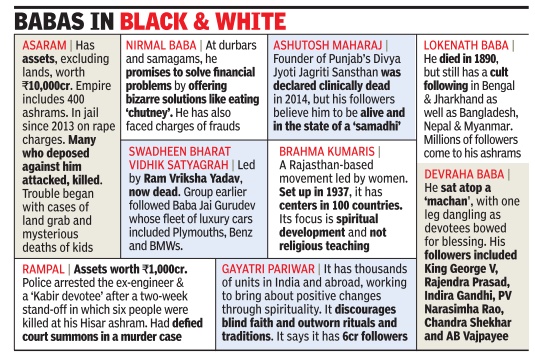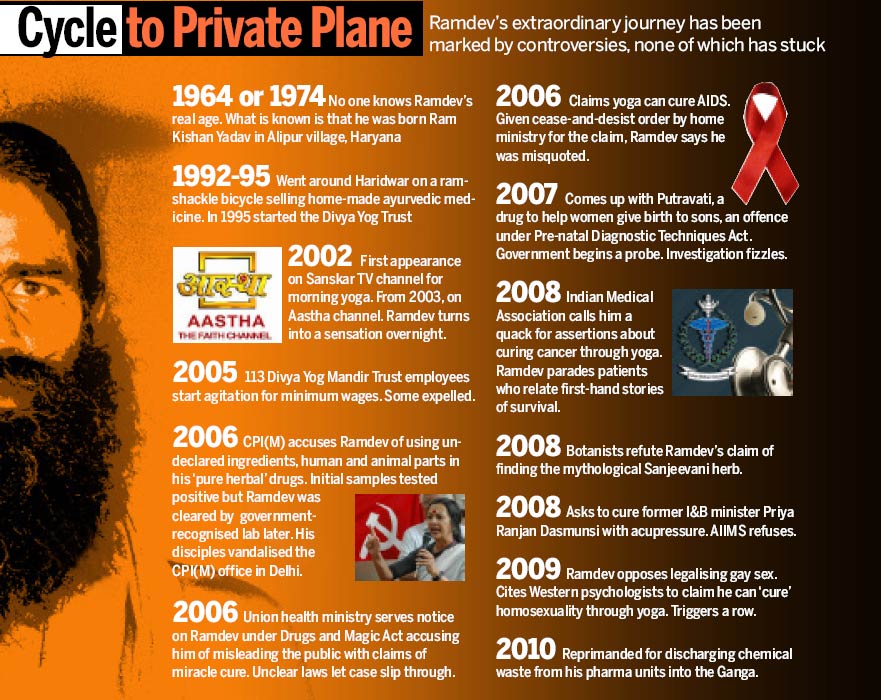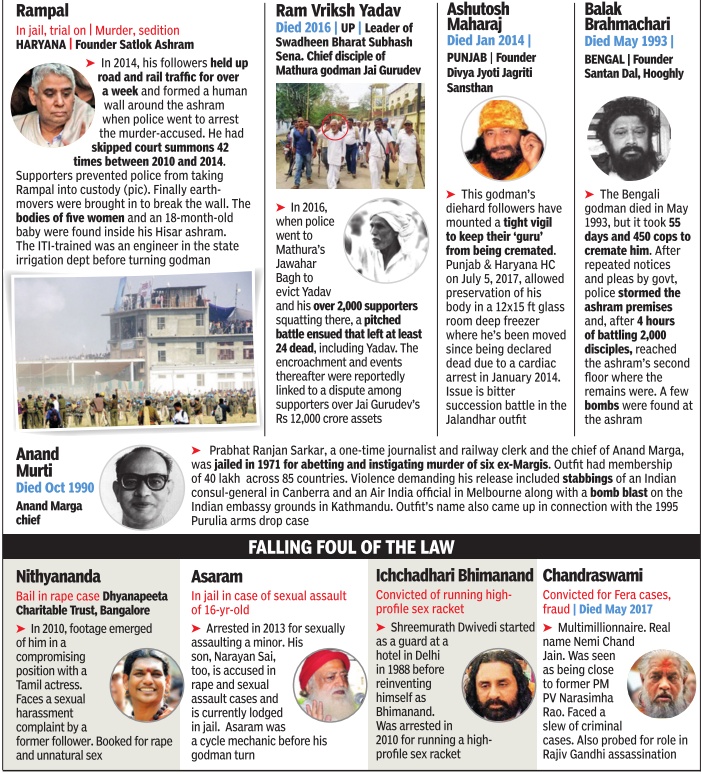Godmen and cult leaders: India
This is a collection of articles archived for the excellence of their content. |
The world of godmen: From sublime to ridiculous
The Times of India, Jun 06 2016

There are godmen, and there are godmen. While notoriety gains the media's and people's immediate attention, the quiet ones continue with their work with zeal, and in good faith, with no expectation of `coverage'. Swadheen Bharat Vidhik Satyagrah in UP's Mathura district, whose followers clashed with police, is just one of the many such controversial cults with massive assets and a purblind supporters, with their heads facing allegations ranging from land grab to fraud, and from rape to murder. The lawlessness brought back images of violence in Haryana's Hisar district in 2014 when the police arrested a former state government employee calling himself a man of faith, Rampal. Six people were killed in the violence then, with the godman's “commando force“ waging the final battle to “protect“ their chief from cops. Ram pal, who had defied court summons in a murder case, was later with slapped with sedition charges. Authorities evacuated more than 10,000 people from the ashram, many of whom said they were held against their wishes.
Asaram is another godman who wielded huge influence and power until he was jailed in 2013 on rape charges.Several people who deposed against him have been attacked, and some killed. His empire includes 400 ashrams in the country and abroad, where he organised “spiritual discourses“ and became famous for his colourful headgear and sprightly dancing.
Then, Nirmaljeet Singh Narula alias Nirmal Baba, who failed as a businessman in Jharkhand, drew dubious publicity with his durbars that were telecast by three dozen Indian and foreign channels. At these events, Nirmal Baba gave solutions like eating chutney to solve financial problems. He faces allegations of fraudulent activities.
Last Friday in Odisha, officials razed an illegal complex on 20 acres of forest land near Konark Sun temple by one Bana baba, who is absconding. People also set fire to one Sura Baba's ashram for land grab. He too was arrested. The ashram of one Anand Atma was also ransacked after a half-burnt body of a local youth was found.
At the same time, there are spiritual organisations raised around pure devotion.Brahma Kumaris is a Rajasthan-based spiritual move ment led by women. Established in 1937, the organisation has about one lakh followers in Rajasthan. Worldwide, it has 10 lakh followers in 135 countries. “Our focus is spiritual development and not religious teaching,“ said sister Sushma Devi, who manages a centre in Jaipur.
Similarly, Gayatri Pariwar, founded by Acharya Shri Ram, has thousands of units in India and abroad, working with its six crore followers to bring about positive changes through spirituality with the motto `Hum badalenge, yug badalega'. Lokenath Baba died in 1890, but he still has a cult following in Bengal and Jharkhand as well as Nepal, Bangladesh and Myanmar.Millions of followers assemble at an annual festival held in his remembrance in ashrams in early June 2016.
Yogoda Satsanga Society , founded by Paramhansa Yogananda in 1917, was one of the earliest pioneers to establish yoga in the West, where it's known as Self-Realisation Fellowship. Headquartered in Dakshineswar, in West Bengal, it teaches meditation techniques of the Kriya Yoga, as well as other aspects of balanced spiritual living.
Controversial godmen
Godmen in controversy
Ann Schaufuss
She got media attention in May 1979. What's a jetsetting Yves St Laurent model doing in a sari and a sandalwood tika? Ann Schaufuss is not just the queen of haute couture in Paris, she is also a Hare Krishna devotee.
Asaram Bapu
For a couple of years, self-proclaimed Godman Asaram Bapu has been in the news for only wrong reasons. He recently hit headlines with a shocking statement where he allegedly had claimed that the 23-year-old victim of infamous gangrape in Delhi could have saved herself if she had addressed her attackers as "brothers" and chanted "Saraswati Mantra". Also, in 2008, two minor boys of his Ashram in Ahmedabad were found dead in the Sabarmati riverbed two days after they mysteriously went missing from the gurukul in February 2008.
Spiritual leader Asaram Bapu was denied the bail as the prosecution lawyer claimed during the proceedings that Asaram has paedophilia, a disease which is characterized by sexual interest toward children. The spiritual guru was presented before court of the district and sessions judge.
When godman Asaram was tongawala Asumal of Ajmer
From the archives of The Times of India
Kshitiz Gaur
September 04, 2013
Self-claimed godman Asaram rode a tonga for a living for at least two years in Ajmer before reinventing himself as a spiritual man. As young Asumal, he carted pilgrims on a pony cart from the railway station to Ajmer Sharif Dargah. Others of his ilk still remember him as Asumal, the tongawala with cushion seats – most of them had wooden boards. After partition, Asumal’s father, Taumal Harpalani, had come to Gujarat from Pakistan’s Sindh. Asumal was seven and the family lived in acute poverty. He worked in different cities of Gujarat before the family came to Ajmer in 1963. Asumal lived with an uncle in the Kharikui locality. “He used to sit with the tongawalas on Kharikui Chowk and would also have haircut from a shop in the corner,” said Charan Jeet Singh Oberai, an advocate. Asumal would take passengers up to Dhanmandi at the gate of the Dargah. “He once participated in a tonga race from Ajmer to Sarwar during the annual Sarwar Urs,” said 75-year-old Heera Ustad, general secretary of the tonga union. “Much later, we came to know he had become a godman,” he said. People also said Asumal loved children and whenever he failed to get passengers he would take children out for a ride. People who knew him as Asumal never expected him to become a godman. “He was ambitious and wanted to get rich. He went back to Ahmedabad and we never heard anything about him until he became Asaram,” they said.
Baba Gurmeet Ram Rahim Singh
He was charged by CBI in a rape case. The Dera chief had been charged with sexually assaulting women followers of the Dera at the sect's Sirsa-based headquarters. He had been booked under Sections 376 and 506 of the IPC. See Gurmeet Ram Rahim Singh Ji Insan
Baba Ramdev
Yoga guru Baba Ramdev, who now supposedly finds more interest in politics than Yoga, was under the scanner when a news channel reported numerous financial irregularities and tax evasion being practiced by his trusts. His non-profit firms are allegedly involved in activities prohibited for non-profit tax-exempt organisations in USA. In 2012, his trusts lost their exemption from payment of Income Tax and were slapped a notice of Rs 58 crore demand on the sale of their Ayurvedic medicines
A profile


The saffron-clad Baba lent his weight to BJP's election campaign by sounding the bugle of discontent against the incumbent Congress over the issue of black money and corruption.
His food supplements and medicine products empire is worth Rs.2,000 crore, operating through 5,000 big franchises and 5,000 additional small franchisees selling over 500-plus products across the country.
He continues to share a special relationship with the BJP and was one of only nine people nominated by Prime Minister Narendra Modi for the Clean India campaign in October 2014. Ramdev carries a low-cost 'swadeshi' Micromax mobile to go with his austere lifestyle.
Balak Brahmachari
IP Singh, December 07 2014
In 1993, followers of Balak Brahmachari in West Bengal made claims of “nirvikalap samadhi“ and kept his body on ice for 55 days.Brahmachari had died in a clinic, but his followers ignored cremation notices and pleas by government officials that his decomposing body was a health hazard. Eventually, the body had to be forcefully taken from the ashram in Sukchar, on the banks of the Hooghly , where it was being guarded by Brahmachari's Santan Dal followers.
Coincidentally , one of the key members of the police operation was an IPS officer of Punjab origin. Rachhpal Singh, who was then SP of 24 Paragnas. Doctors had certified Brahmachari's death but his followers brought the body to the Santan Dal headquarters and kept it in a room where half-a-dozen air-conditioners were fitted and the room was filled with ice. Singh says he received a tip-off about the management's plans. They were preparing his younger brother to take his place, asking him to grow his beard and hair. They would have then declared that Brahmachari had come back.“
The police knew they had to act fast, as Brahmachari's followers were distributing `charnamrit' from the melting ice on which he was kept, and was a sure health hazard. On the night of June 29, 1993, that government decided to remove the body and Singh was to lead the operation.The gate was closed with thousands of angry followers inside. They had also made preparations for mass suicide to defame the police.Except for around 10 policemen, the rest fled. According to Singh,it took the cops five hours to reach the room where Brahmachari's body was kept. They found it badly decomposed and full of maggots. Today there is not even a single follower of Balak Brahmachari and his sect has disappeared.“
Chandraswami
Nemi Chand Jain, alias Chandraswami, claimed to be a psychic, an astrologer and a faith healer. He had registered as many as nine FERA cases and the CBI has lodged a cheating case and a case for his involvement in the conspiracy to assassinate former Prime Minister Rajiv Gandhi in 1996.
Ganga Bhajan Kaur
She got nation’s attention in March 1976. With Ganga Bhajan Kaur aka Suzy Burns of California, a believer of Sikhism and kundalini yoga, the country is resounding with the strains of Gurbani Kirtan.
Jayendra Saraswati
The Kanchi math Shankaracharya, was arrested by the Tamil Nadu Police in November 2004 in connection with the murder of math's accountant. He still is an accused in the case.
Maharishi Mahesh Yogi
Actress Mia Farrow accused the Beatles’ friend Maharishi Mahesh Yogi of molesting her when she visited the celibate guru with the band in 1968. Apparently, he groped her in his cave. The Beatles were offended enough by their supposedly celibate friend’s libido to write a song that initially went, ‘Maharishi, what have you done/ you’ve made a fool of everyone/’ later, the words Sexy Sadie were used instead of ‘Maharishi’
Nandamuri Taraka Rama Rao
He got media attention in May 1983. When actors turn politicians, they barely give up their thespian habits. Andhra Pradesh CM N.T. Rama Rao is heard saying: "I am no longer the lustful and gorgeous-looking Rama Rao but a yogic CM."
Nirmal Baba
'Daswand' or the receiving of donations of one-tenth of a devotee's earning — has landed self-styled spiritual guru Nirmal Baba in trouble with a notice having been slapped on him for alleged service tax evasion of Rs 3.5 crore. The central excise department issued the notice on the grounds that 'Daswand' amounts to charging devotees attending a 'Samagam' (congregation) an entry fee for a 'service', official sources said.
Pawan Diwan
He got nation’s attention in July 1977. With his bare torso, flowing hair and electrifying speech, godman Pawan Diwan, 31, has won assembly elections on a Janata Party ticket in Madhya Pradesh.
Prabhat Ranjan Sarkar
The railway accounts clerk who founded the Ananda Marg, a socio-religious group, was arrested on a murder charge but was acquitted in 1978 by the Patna High Court.
Prakashanand Saraswati
The founder of the Barsana Dham Centre in Texas in 1990, was indicted on 20 counts of indecency with a child by sexual contact between 1993 and 1996. He was absconding and has been sentenced to 14 years in prison and fined USD 10,000 on each of 20 felony counts for groping girls.
Premananda or Trichy Sai Baba
He was awarded life imprisonment in 1994 for two terms on the charges of multiple criminal offences including rape and murder. Premananda was punished for raping inmates of his ashram and carrying out medical terminations of some of the consequent pregnancies with the help of a couple of associates.
Radhe Maa
See Radhe Guru Maa (Param Shradhey Mamtamai Shri)
Rampal
see Rampal Singh Jatin @ Rampal, cult leader
Sudhanshu Maharaj
In 2010, a businessman Mahaveer Prasad Mansinghka filed a complaint in the local court in Shajapur alleging that Sudhanshu Maharaj's 'Vishwa Jagriti Mission' to whom he had donated Rs 53 lakh for getting relaxation under section 80-G of the Income Tax Act was turned down by the department on the ground that the Mission had no such facility. A non-bailable warrant was also issued against the self-proclaimed godman. However, High Court's Indore Bench stayed the execution of non-bailable warrant issued against the noted saint.
Swami Bhimanand Ji
Shiv Murti Dwivedi alias Sant Swami Bhimanand Ji Maharaj Chitrakoot Wale was arrested by the Delhi Police in 2010 on charges of operating a high-profile sex racket involving former air hostesses and students
Swami Nityananda
In 2010, self-styled godman Swami Nityananda was found involved in a sex scandal after a news channel released footage showing him in a compromising position with film actress, Ranjitha. Despite the controversy, Panchayati Akhara Mahanirvani bestowed on him the title of maha-mandaleshwar in 2013.
Sai Baba (Sathya) of Puttaparthi
Sri Sathya Sai Central Trust was founded by Bhagawan Sri Sathya Sai Baba on 2nd September, 1972. Under Bhagawan's guidance, the Trust has been undertaking a number of welfare activities such as providing free education at school and university levels, delivering quality medical care at primary, secondary and tertiary levels completely free of charge, supply of pure drinking water in various regions of the state of Andhra Pradesh and the metropolitan city of Chennai. Other activities of the Trust include preservation and propagation of the rich culture and heritage of India through construction of museums, convention centers, community halls etc. Thus, it has been His instrument, translating into action His message of selfless love, touching the lives of millions. It has actively initiated the economic, moral and spiritual regeneration of society and today stands as a paragon of service worthy of emulation.
Swami Sadachari
Once spiritual advisor and tantric of many top politicians including former Prime Minister Indira Gandhi has been in jail for running a brothel. The once-influential godman, who is believed to have performed rituals at a prime minister's residence, was nabbed only when he fell out of favour with those in power.
Syed Gulzar
A 42-year-old self-styled Sufi dervish Gulzar Ahmed Bhat was recently arrested by Jammu and Kashmir police for raping and sexually abusing several young girls at his religious centre, Khansahib in Budgam district. Gulzar Bhat, who went by the name Syed Gulzar, allegedly ran a residential institution for girls which offered short duration courses in religious studies. He is currently in jail.
Godmen who fought court battles
1970s-2017

From The Times of India, August 26, 2017
See graphic, ' Godmen and their fought court battles, 1970s-2017'
Inheritance of assets
1997-2017: some cases
Amid chaos, Sirsa-based Dera Sacha Sauda appealed to its supporters to not believe in any succession rumours following the conviction of its head Gurmeet Ram Rahim Singh in a rape case.
“There are a lot of rumours being spread about the announcement of a successor by the Dera Sacha Sauda or revered Guruji. You (followers) will have to stay away from such rumours,“ Dera chairperson Brahmachari Vipasana said in a video message released on her Twitter handle.
The battle of succession in Sirsa is neither unprecedented nor unexpected. For godmen in India, the toughest challenge has been to hold the flock together while passing on the mantle. Succession wars have witnessed much bickering and bloodletting, eventually leading to the downfall of the cults.
Jai Gurudev, who had a massive following in UP , Bihar and parts of MP , left behind a legacy worth over Rs 12,000 crore, according to some claims. When the self-pro claimed godman died on May 18, 2012, his assets included Rs 100 crore in cash and 250 luxury cars worth Rs 150 crore. He had a big ashram in Mathura and properties in many cities. His driver, Pankaj Yadav, claimed ownership of the assets showing a will in his favour.
Another claimant, Umakant Tiwari, formed a separate group of the sect and settled in Ujjain. Another splinter group, led by Ram Vriksha Yadav , later occupied Mathura's Jawahar Bagh and led hundreds of his supporters in violent clashes with the police which resulted in the death of two policemen and 22 squatters in June 2016.
In August 1997, Prem Kumar Somasundaram, known as Swami Premananda was given a double life sentence by the SC. After he was jailed, there was confusion over who would control his huge assets.
With his resemblance to Sathya Sai Baba, Premananda was popular in southern states and had set up a 150acre ashram in Tiruchi with branches in 15 countries. The godman's second-in-command, Kamalananda, was also jailed and given double life sentence along with his guru.
Even as the trial was on, Divya Mathaji, a confidante of the godman and incharge of ashram inmates, fled to Germany and later to France. Assets worth Rs 80 lakh in her name were frozen. Premananda died on February 21, 2011 in Cuddalore central prison.
The Difference Between Fake and True Gurus
The Difference Between Fake Babas & True Gurus
Yogi Ashwini The Times of India Dec 19 2014
On a TV show recently , the anchor commented, “If you are good at nothing in life become a Baba; the chances of your becoming successful and prosperous are very high.“ This seems to be the common perception! Perhaps this is so because today several self-proclaimed `babas' and `saints' take to wearing saffron, green or white. Their wardrobe, length of beard, the ailments they claim to cure you of and the crowds they pull are all taken as yardstick to gauge their Spiritual Quotient. Vulnerable devotees lavish praise, power and wealth on their professed Baba, helping set up `ashrams' in the name of elevating consciousness.
How then do we differentiate between a fly-by-night Baba and a truly evolved Guru? There are others, who, after years of rigorous tapa and sadhana, despite having achieved all that they had to in material life, take to a higher search and have interactions and exchanges with the world of energy . Such a one may not sport a beard and may live in T-shirts and track pants he may not even call himself a saint or baba. The question then arises: Who is a guru and what does one need him for?
I detail here some of the traits of a guru as mentioned in the vedas. The same may be applied universally by anyone who is looking to find a spiritual guide. The vedas say that a guru exudes radiance. He has to channelise energy , and for that purpose, his body is strong and free of disease. Whatever he says or thinks manifests, his chants have the effect of completely changing the environment of a place, diseases get cured by his gaze alone and phenomenal energy is transferred by his touch.
A true guru is in a state of vairagya or detachment from the pleasures of the physical world. He may choose to lead a life of luxury as everything is at his beck and call, but he is not attached to it. He has com attached to it. He has com plete control over the elements and the five senses. When you are in his company , you experience the same sense of detach ment within you, your thoughts and desires begin to manifest, your complete form changes, you stop falling sick and your involvement in charitable activities increases manifold.Experiences of the world of energy and subtler dimen sions follow.
The vedas clearly state that a guru is satya speaks the truth; asteya does not steal from you or country; aparigraha does not amass assets or political power; ahimsa non-violent; and brahmacharya is celibate. Such a guru does not charge you a fee or ask for physical favours in exchange for yoga, because he knows that tying of yogic sciences to maya renders them ineffective. A guru may earn his living, but does not sell knowledge of yoga.
The purpose of a guru is not to cure your illnesses or rid you of your physical problems, but to show you what lies beyond, from where all that you see around is controlled, and put you on the path of achieving that.This guru does not organise rave parties where drugs are served and does not organise social gatherings where intoxicated people dance to music. So do not go looking for a baba, go look for a guru. A baba will tie you in knots; a guru will release you from them.
The origin and spread of deras, guru-peers
DEVDUTT PATTANAIK, Decoding the rise of the poor man's guru, September 3, 2017: The Times of India
The upper class contempt for Baba Gurmeet Ram Ra him Singh ji Insaan was evident long before his conviction on rape charges. Those gaudy clothes. Those songs. Those films. It was vulgar conspicuous consumption, unworthy of a holy man. And then came the c o nv i c t i o n , followed by riots by the `subalter n'.The upper classes were livid. Their gurus would never do such a thing, all those whispers of murder, encroachment and abuse notwithstanding.
The rise of gurus in India, for all its talk of equality and transcendence, must be seen in the context of India's class, caste and ruralurban hierarchies. The rise of the `dera' culture in Punjab is just a case in point.
Dera means encampment in Punjabi. From the 10th century onwards, we hear of sages like Gorakhnath who would come and set up a dera near a village and people would go to him and seek spiritual guidance, which is a combination of psychotherapy and magic. At one level, he would speak of the meaning of life, of suffering, of coping with the world, and give solace to broken souls. At another level, he would bring fortune into the lives of the poor, grant children to the childless, and cure the ill. Then there would be the whispers of miracles: light emanating from his body, walking on water, flying through air and communicating with God. Under influence of Islam, the guru came to be seen as God's messenger, prophet or paigambar, (paigam, in Persian), or a pir (elder, in Persian) with an intimate connection with God.
The gurupir spoke in simple language, and helped break the stranglehold of the Brahmins who seemed to have exclusive access to God (brahman, means divinity). He was simple and approachable, and so more loved than the Kshatriyas or landowners (kshetra, means land). He asked for nothing in exchange and so was preferable to the bania, who controlled the markets, demanded payment for everything, gave loans, and put people in debt. The most influential of these sages who spoke of love and equality was Guru Nanak, who lived 500 years ago. He rejected the caste (jati) system that defined hierarchy in India.
But ancient and medieval societies always had hierarchies.We often forget that the Greeks who introduced the idea of justice did not believe in equality.Equality was a Christian idea, rooted in old Arabic tribal egalitarianism, and so naturally prescribed by the God of Abraham.Of course, to be treated as equal, one had to belong to the tribe, to the `dera', swear allegiance to the God and his messenger. Thus the idea of Christian equality shook the foundations of the Roman Empire, and the idea of Islamic equality shook the foundations of the Persian Empire.
Guru Nanak's words challenged the Hindu caste hierarchy .A few generations later a new religion came into being, Sikhism, on the interface of Hinduism (importance to song and music) and Islam (importance to the book, and the saint-leader). It gradually institutionalised itself. And like all institutions, introduced an unspoken hierarchy, of those who were truest to the faith, and those who were not. The British helped this process, through documentation and creation of office bearers, to ensure the division between Sikhism and Hinduism was clear, and in no doubt.
And before you knew it, the old caste hierarchies returned. The landowning and trading communities, the Jats and the Khatris, took charge of the faith and its institutions. The Dalit Sikh who included uneducated labourers, landless peasants, sanitary workers, were firmly shown their aukaat (status, in HindiPunjabi) in the new order. This established a need for a new set of deras, one that focussed on the poor, and the uneducated who had been cheated by the promise of equality .
It is this `spiritual market' that the deras serve. And the influence is largely positive. Rather than taking to alcohol and drugs, the followers and disciples choose to obey their guru: work hard, live simple lives, stay faithful to their wives, become vegetarian (pan-Indian code for purity), and feel their lives have meaning and identity . They `belong'.
This identity comes from allegiance to the guru, and allegiance is demonstrated through obedience. Absolute devotion is translated as absolute loyalty.Power is outsourced to the guru in the name of `ego-less-ness'. But what happens to the guru then? Can he, or she, handle the power bestowed upon him? Rape, like land-grabbing, is a symptom of a deep dark malaise.
The assumption of `transcendence' means that the guru who can overturn the laws of nature (water becomes wine) as well as laws of culture (hierarchies collapse), is not intimidated by mundane earthly boundaries established by consent and regulation. He, or she, can do with his flock, what God does to his creation. Thus, the guru who mocks maya (worldly delusion) is entrapped by maya. And this is true as much for the gurus of India, as it is for the gurus of Bharat, and the diaspora.
What makes these ‘godmen’ popular?
The dera culture of Punjab- Haryana
Avijit Ghosh, `Gurmeet Ram Rahim reinvented dera culture', August 26, 2017: The Times of India
What explains the huge popularity of deras in Punjab? Pramod Kumar, a social scientist, seeks to decode the reasons behind their rise & growth
What are the social roots of the deras?
The deras are poor cousins of institutionalised religions.They primarily represent the disadvantaged subaltern and the lower middle class. Their followers are people who subsist on the margins both in terms of economy and the caste system. There is no caste discrimination in deras.
What has caused the spread of deras?
The followers of the deras feel largely excluded from institutions such as village panchayats, district administrations, police and courts.Their daily experiences range from denial of identity and dignity and coercive extraction of labour. They have far greater faith in the dera than in the political class or judiciary. They feel the dera is morally superior to these institutions. For instance, many women like deras because they preach against consumption of alcohol and drug abuse which leads to lessening of domestic violence.The deras are a sub-culture; they create a new social capi tal which the followers appropriate. People also start marrying within the deras.
Over the years, deras have accumulated land and property through state patronage, donations and business, enabling them to subsidise the impoverished, give them cereals and provide access to health facilities. Wherever the government and the political class fail, the deras step in and deliver. Followers believe deras have brought them the achhe din the state couldn't. The political class always tries to use their support base to their advantage in polls, while self-proclaimed godmen exploit the complete allegiance of followers to put pressure on the law.
What explains the popularity of the Dera Sacha Sauda chief ?
He has reinvented the dera culture in a new market-driven economy. He wears flamboyant costumes and ornate jewellery, acts in films and makes money from them. He also knows how to use the electronic and social media.
Would you say that deras are a form protest against other religions?
Institutional religions have been intolerant of lower castes and have pushed them towards deras, which are a confluence of castes and religions.
Why is Punjab such a fertile ground for deras?
In Punjab, religious oral tradition is very strong. People don't interact as much with the text as listen to religious discourses (pravachans). In this cultural backdrop, gurus who can deliver sermons become popular. Punjab is known for its liberal religious tradition.Jainism, Buddhism, Sikhism, Brahmo Samaj, Arya Samaj -different religions and sects found a place here. When people do not get to practice religion the way they want, they move to other choices.
See also
Godmen and cult leaders: India <>Ann Schaufuss <> Asaram Bapu <> Dera Sacha Sauda <>Gurmeet Ram Rahim Singh Ji Insan <> Radhe Guru Maa (Param Shradhey Mamtamai Shri) <> Rampal Singh Jatin @ Rampal, cult leader <>Virender Dev Dixit/ Adhyatmik Vishwavidyalaya
At a different level, see Sai Baba (Sathya) of Puttaparthi
